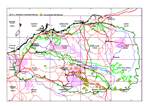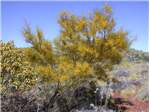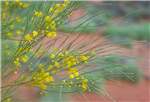Click on images
to enlarge



Photographer: B.R. Maslin

Photographer: E. Thoma

Photographer: B.R. Maslin
, BRM 8709, photo J. Maslin, ORIGINAL SCAN_sml.jpg)
Pods immature. Photographer: J. Maslin
, A Mitchell PRP1005, lab photo by Fiona McCallum ADJUSTED_sml.jpg)
Seed from one herbarium voucher. Scale in mm. Photographer: F. McCallum.
Botanical name
Acacia pachyacra Maiden & Blakely, J. Roy. Soc. W. Australia 13: 21, pl. 14, figs 1-7 (1928)
Description
Bushy glabrous shrubs or small trees 1-5 m tall but frequently 1-3 m, branching at or near ground level into a few ascending to erect main stems, wind passing through the soft, dense canopy produces a soothing, hissing sound like when under a Sheoak (Casuarina/Alocasuarina) or Athol Pine (Tamarix). Bark grey, slightly roughened at base of trunks otherwise smooth, upper branches of mature plants and stems of young plants are greenish bronze or reddish brown and often slightly pruinose. Branchlets slender. Phyllodes slender, quadrangular to ±terete, rarely flat, 8-20 cm long, 0.5-1 mm wide, delicate and not rigid, ascending to erect, straight to shallowly curved, smooth when fresh but slightly longitudinally wrinkled or grooved when dry, light green to grey-green or sub-glaucous; with 4 fine longitudinal nerves. Gland on upper margin of phyllode 0-2 mm above pulvinus, an additional smaller gland below the thickened, non-spiny point. Inflorescences short racemes 10-30 cm long, raceme axes slender; peduncles 4-7 mm long, slender; heads globular, rather small, bright light to mid-golden, 20-30-flowered. Flowers 5-merous; sepals free, linear-spathulate. Pods narrowly oblong, flat but prominently rounded over seeds along the midline, 4-8 cm long, 7-11 mm wide, chartaceous, light brown. Seeds transverse to oblique in the pods, obloid to widely ovoid-ellipsoid or orbicular, (4-) 4.5-5.5 mm long, shallowly depressed at centre, not shiny, black; exarillate.
Characteristic features
Bushy glabrous shrubs or small trees, wind passing through the soft, dense canopy produces a soothing, hissing sound like when under a Sheoak (Casuarina/Alocasuarina) or Athol Pine (Tamarix). Phyllodes long and slender (8-20 cm x 0.5-1 mm), delicate and not rigid, normally quadrangular to ±terete, with a small gland located at the base of the thickened, apical point. Inflorescences short racemes (10-30 cm); heads globular on short (4-7 mm), slender peduncles. Pods relatively broad (7-11 mm), flat but prominently rounded over seeds, papery, light brown. Seeds dull and black, funicle thread-like (not expanded into an aril).
Distribution and ecology
Occurs in the western part of the arid zone from the Pilbara to the Docker River area in Western Australia, eastwards through Northern Territory and to far north western South Australia. In the Pilbara it is most commonly found in the Hamersley and Ophthalmia Ranges where it predominates in the Tom Price - Wittenoom area, east to Newman, with an apparent outlier near Mt Farquhar, about 100 km northwest of Tom Price; it extends east of Newman to Balfour Downs Station. Acacia pachyacra typically grows in red sand (pH 4.5-5.5) on plains or dunes in spinifex country but in the Pilbara it is also found on red loamy soils with a pebble surface strew, particularly on bajada slopes footing ranges and ridges of banded ironstone. Acacia pachyacra is a disturbance opportunist and responds particularly well after fire. It often forms dense thickets in alluvial washes above the main channel of flow lines in bajada slopes. In good seasons it is a prolific flower and attracts a wide varies of coleopteran and other flying insect to its fragrant flowers. The species also has the ability to resprout advantageously from the base of the stem after mechanical disturbance and after a mild fire also resprouts advantageously from rootstock up to several metres removed from the presumed parent plant. The seeds of this species also germinate readily and often without the required dominancy breaking cues for germination. The species is short-lived and senesces rapidly within 5 years of establishment, this senescence is often promoted by a proliferation of borers in the branches and main stem. Used extensively in the mine-site rehabilitation industry as plants tend to be prolific seeders, are quick growers and the seeds have a natural propensity to be distribute widely, probably by ants. Fox and Dunlop (1983) reported up to 14% germination without any seed treatment, a percentage value which was the highest for over 60 Pilbara wattle species examined.
Flowering and fruiting period
It is likely that the flowering period extends from about August to October, however, Pilbara flowering collections have only been made in October. Pods with mature seeds have been collected in November (pods may possibly persist until December/January but there are no collections from these months).
Affinities
Acacia pachyacra is closely related to A. murrayana which has broader phyllodes (A. murrayana does occur in the Pilbara but occurs close to the boundary near Nanutarra on the Ashburton River). It may superficially resemble A. tenuissima in the field on account of its growth form and long, slender phyllodes, however, the two species are not at all closely related (A. tenuissima has finely multi-nerved phyllodes, spicate inflorescences and much narrower pods). In the field A. pachyacra has a distinctly yellow to bright dark green look which readily distinguishes it from A. tenuissima. The zigzag arrangement of young branchlet growth in A. tenuissima is also a useful character when distinguishing the two wattles.
Notes
As with A. pruinocarpa the seeds of A. pachyacra have a high propensity to germinate without any formal removal of a dominancy mechanism (Fox and Dunlop 1983).
This species has the potential for being a showy ornamental for inland areas on sandy soils.
The seed of A. pachyacra is eaten by Aborigines in Central Australia (Latz 1995). Its closest relative, A. murrayana , is considered by Maslin et al. (1998) as one of the most prospective Acacias for cultivation in semi-arid regions as a source of food for human consumption.
Conservation status
Not considered rare or endangered.
Origin of name
The botanical name is derived from the Greek pachys (thick) and akron (top, summit) and refers to the characteristically thickened mucro that terminates the phyllodes.
References
Fox, J.E.D. and Dunlop, J.N. (1983). Acacia species of the Hamersley Ranges, Pilbara Region of Western Australia. Mulga Research Centre. Occasional Report No. 3. pp. 94. (Western Australian Institute of Technology: Bentley.)
Latz, P.K. (1995). Bushfires and Bushtucker: Aboriginal plant use central Australia. pp. 400. (IAD Press: Alice Springs.)
Maslin, B.R., Thomson, L.A.J., McDonald, M.W. and Hamilton-Brown, S. (1998). Edible Wattle Seeds of Southern Australia: A review of species for use in semi-arid regions. pp. 108. (CSIRO Publishing: Collingwood, Victoria.)
